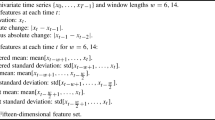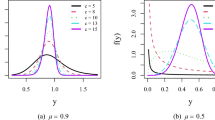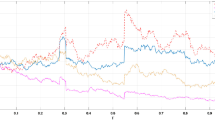Abstract
This paper discusses extensions of the implied diffusion approach of Dupire (1994) to asset processes with Poisson jumps. We show that this extension yields important model improvements, particularly in the dynamics of the implied volatility surface. The paper derives a forward PIDE (PartialIntegro-Differential Equation) and demonstrates how this equationcan be used to fit the model to European option prices. For numerical pricing of general contingent claims, we develop an ADI finite difference method that is shown to be unconditionally stable and, if combined with Fast Fourier Transform methods, computationally efficient. The paper contains several detailed examples fromthe S&P500 market.
Similar content being viewed by others
References
Ait-Sahalia, Y., Yubo Wang, and Francis Yared. (1998). “Do Option Markets Correctly Asses the Probabilities of Movements of the Underlying Asset?” Forthcoming, Journal of Econometrics.
Amin, Kaushuk. (1996). “Jump Diffusion OptionValuation in Discrete Time,” Journal of Finance 48, 1833–1863.
Andersen, Leif, and Rupert Brotherton-Ratcliffe. (1998). “The Equity OptionVolatility Smile: AFinite Difference Approach,” Journal of Computational Finance 1, 2, 5–38.
Andersen, Torben, Luca Benzoni, and Jesper Lund. (1999). “Estimating Jump-Diffusions for Equity Returns,” Working Paper, Northwestern University and Aarhus School of Business.
Andreasen, Jesper. (1997). “Implied Modelling: Stable Implementation, Hedging, and Duality,” Working Paper, University of Aarhus.
Andreasen, Jesper. (1998). “The Pricing of Discretely Sampled Asian and Lookback Options: A Change of Numeraire Approach,” Journal of Computational Finance 2, 1, 5–30.
Andreasen, Jesper, and Barbara Gruenewald. (1996). “American Option Pricing in the Jump-Diffusion Model,” Working Paper, Aarhus University and University of Mainz.
Avallaneda Marco, Craig Friedman, Richard Holmes, and Dominick Samperi. (1997). “Calibrating Volatility Surfaces via Relative-Entropy Minimization,” Applied Mathematical Finance 4, 1.
Bakshi, Gurdip, Charles Cao, and Zhiwu Chen. (1997). “Empirical Performance of Alternative Option Pricing Models,” Journal of Finance 52, 2003–2049.
Bates, David. (1996). “Jumps and Stochastic Volatility: Exchange Rate Processes Implicit in Deutsche Mark Options,” Review of Financial Studies 9, 1, 69–107.
Bjork, Tomas, Yuri Kabanov, and Wolfgang Runggaldier. (1997). “Bond Market Structure in the Presence of Marked Point Processes,” Mathematical Finance 7, 211–239.
Black, Fischer, and Myron Scholes. (1973). “The Pricing of Options and Corporate Liabilities,” Journal of Political Economy 81, 637–654.
Boyle, Phelim, Mark Broadie, and Paul Glasserman. (1997). “Monte Carlo Methods for Security Pricing,” Journal of Economic Dynamics and Control 21, 8–9, 1267–1321.
Breeden, Douglas, and Robert Litzenberger. (1978). “Prices of State-Contingent Claims Implicit in Options Prices,” Journal of Business 51, October, 621–651.
Brown, Gregory, and Klaus Toft. (1999). “Constructing Implied Binomial Trees from Multiple Probability Distributions,” Journal of Derivatives 7, 2, 83–100.
Buraschi, Andrea, and Jens Jackwerth. (1998). “Explaining Option Prices: Deterministic vs. Stochastic Models,” Working Paper, London Business School.
Coleman, Thomas, Yuying Li, and Arun Verma. (1999). “Reconstructing the Optimal Volatility Surface,” Journal of Computational Finance 2, 3, 77–102.
Chriss, Neill. (1996). “Transatlantic Trees,” RISK July, 45–48.
Das, Sanjiv, and Silverio Foresi. (1996). “Exact Solutions for Bond and Option Prices with Systematic Jump Risk,” Review of Derivatives Research 1, 7–24.
Derman, Emanuel and Iraj Kani. (1994). “Riding on a Smile,” RISK Magazine February, 32–39.
Dierckx, Paul. (1995). Curve and Surface Fitting with Splines. Oxford Science Publications.
Dumas, Bernard, Jeff Fleming, and Robert E. Whaley. (1997). “Implied Volatility Functions: Empirical Tests,” Journal of Finance 53, 2059–2106.
Duffie, Darrell, Jun Pan, and Kenneth Singleton. (1999). “Transform Analysis and Option Pricing for Affine Jump-Diffusions,” Working Paper, Stanford University.
Dupire, Bruno. (1994). “Pricing with a Smile,” RISK Magazine January, 18–20.
Heston, Steven. (1993). “A Closed-Form Solution for Options with Stochastic Volatility with Applications to Bond and Currency Options,” Review of Financial Studies 6, 2, 327–343.
Hull, John, and Allan White. (1987). “The Pricing of Options with Stochastic Volatilities,” Journal of Finance 42, 281–300.
Jackwerth, Jens. (1996). “Generalized Binomial Trees,” Working Paper, University of California at Berkeley.
Karatzas, Ioannis, and Steven Shreve. (1991). Brownian Motion and Stochastic Calculus. Springer Verlag.
Kloeden, Peter, and Eckhardt Platen. (1992). Numerical Solution of Stochastic Differential Equations. Springer Verlag.
Krishnan, Venkatarama. (1984). Nonlinear Filtering and Smoothing. John Wiley and Sons.
Lagnado, Ronald, and Stanley Osher. (1997). “Reconciling Differences,” RISK Magazine April, 79–83.
Merton, Robert. (1976). “Option Pricing when Underlying Stock Returns are Discontinuous,” Journal ofFinancial Economics May, 125–144.
Mitchell, Andrew, and D. F. Griffiths. (1980). The Finite Difference Method in Partial Differential Equations. John Wiley & Sons.
Naik, Vasant, and Moon Lee. (1990). “General Equilibrium Pricing of Options on the Market Portfolio with Discontinuous Returns,” The Review of Financial Studies 3, 493–521.
Papparlardo, Luca. (1996), “Option Pricing and Smile Effect when Underlying Stock Prices are Driven by a Jump Process,” Working Paper, University of Warwick.
Press, William H., Saul A. Teukolsky, William T. Vetterling and Brian P. Flannery. (1992). Numerical Recipes in C. Cambridge University Press.
Rubinstein, Mark. (1994). “Implied Binomial Trees,” Journal of Finance 49, 771–818.
Stein, Elias, and Jeremy Stein. (1991). “Stock Price Distributions with Stochastic Volatility: An Analytic Approach,” Review of Financial Studies 4, 4, 727–752.
Zhang, X. (1993). “Options Americaines et Modeles de Diffusion avec Sauts,” C. R. Acad. Sci. Paris, Serie I, 857–862.
Zvan, Robert, Peter Forsyth, and Kenneth Vetzal. (1998). “Robust Numerical Methods for PDE Models of Asian Options,” Journal of Computational Finance 1, 39–78.
Author information
Authors and Affiliations
Rights and permissions
About this article
Cite this article
Andersen, L., Andreasen, J. Jump-Diffusion Processes: Volatility Smile Fitting and Numerical Methods for Option Pricing. Review of Derivatives Research 4, 231–262 (2000). https://doi.org/10.1023/A:1011354913068
Issue Date:
DOI: https://doi.org/10.1023/A:1011354913068




